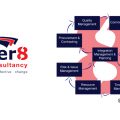Aligning your digital transformation plans with your company culture
.. Last we spoke about aligning your company culture with your digital transformation. The same could be said for aligning your digital transformation plans with your company culture. Everyone wants to invest in more technology, more applications, more methodology, more process. On paper, the benefits are clear.
IDC research shows that by 2027, 75% of companies will have transformed”. But many companies do not realise the benefits and may even not complete their investments.
- 87% of business leaders say that digitalisation is a company priority.
- Only 49% of chief executives report that business model change is already underway
- 66% add that they expect their business model to change within the next three years.
As experienced by many a transformation, if you try and bring about transformational change in a complex company, you will fail. And you’ll fail even if you’re following best practice. Because best practice doesn’t know the context of the environment that you’re in. The simple principle should be heeded:
“You can’t teach a five-year-old algebra without them first learning how to count.”
BUSINESS MATURITY:
Change requires people, all of whom have different habits. The sum of those habits in any company make up the ways of working, or as is often referred to “the way things are done around here”. The usual quote relating to a company’s cultural environment. So, to be effective in your change, you must morph best practice to fit the environment. Then progress that environment slowly up the maturity curve.
This is an example of a maturity curve which displays the various levels of organisational maturity. It’s a helpful guide for businesses trying to work out where they fit, and what steps to take as a result.
MERGERS:
Similarly, one of the main reasons for mergers which don’t deliver benefits is business leaders who complete an assessment of who to merge with, without looking at culture. They might assess the products/services, and the commercials, and then bring together two groups who can’t work together because the cultures are totally contradictory.
The solution is either to fully evaluate the culture as part of the decision or to invest in bringing them together successfully.
CASE STUDY:
In 1998, Daimler-Benz (Benz) and Mercedes-Benz, announced a $36 billion merger with the Chrysler Corporation. It quickly became apparent that Benz would be the dominant partner, holding the majority of the new company’s shares.
After a few months, the new company’s (DaimlerChrysler AG) stock rose to $ 108.62, but it didn’t last. In 2006, Chrysler posted losses of $ 1.5 billion, and in 2007,
Daimler Chrysler announced it was selling 80.1% of Chrysler to a private equity firm. What’s more, Chrysler filed for bankruptcy protection in 2009, subsequently entering a partnership with Fiat.
While a lack of due diligence and a global recession undoubtedly played their part here, cultural differences were reportedly a big player in this M&A failure. Two companies, from different countries, with vastly different working cultures, made realising benefits from synergy – even between their marketing teams – and impossible task.
HOW TO SUCCEED:
1. Your digital objectives should be driven by business objectives
What are your organisation’s digital transformation goals driven by? To get the entire business behind the project, with the desire and ability to make necessary changes within their own business areas, it should be driven by clear business objectives such as customer service enhancements, growth, or employee attraction and retention.
This means that the cross-functional processes change you need can be designed and implemented in a way to suit everyone’s needs. They will also prevent duplicated processes and encourage a more open and collaborative environment, generally.
2. Employee involvement
Give every employee the opportunity to be involved. Some will be concerned that your new digital approach could make their role unnecessary. By getting them up close to your plans in the early stages, you have a better chance of getting their buy-in. And, you can apply their ideas and suggestions to improve customer and employee experiences to your plans.
It’s also highly likely that you’ll uncover a few processes or bits of knowledge. These nuggets of information could otherwise have meant the downfall of the project, or loss of high-value clients or employees. It’s incredible how much information people store in their heads which companies haven’t committed to paper, let alone digitise – because businesses don’t know the information exists unless someone asks for it.
These steps will go far in filtering an acceptance and adoption of change, even to those who are resistant to it at first. They will also help alleviate those fears of automation and could lead to improved job roles, increased training or retraining, all with a positive influence on the organisation and its workflows.
3. Listening to the feedback
You should be engaging key customers as well. But while you’re building your new digital processes and workflows, create a mechanism for seeking and securing users’ feedback – from employees too.
Search out responses on the plans, and each level of implementation so that you can develop the best possible user experience, based on users’ needs. Take into account the current ways of working and work out the steps needed to move to the target state. Doing so in more steps successfully will deliver a far higher ROI than doing it in one step unsuccessfully.
4. Listening to the experts
You know what the business needs, you know what employees need, and you know what customers need. Now listen to the digital and transformation experts who are developing it for you.
If you don’t have the skills in-house, acknowledge it early, and bring in help. It’ll be faster, more efficient and effective, and cheaper in the long run.







